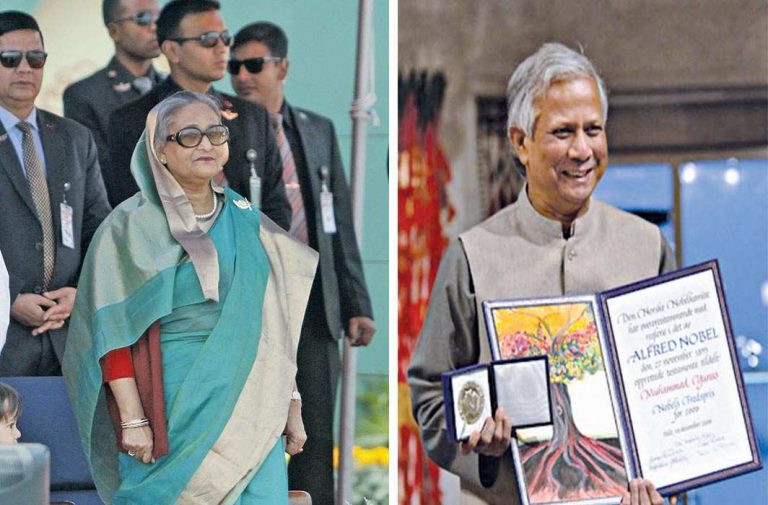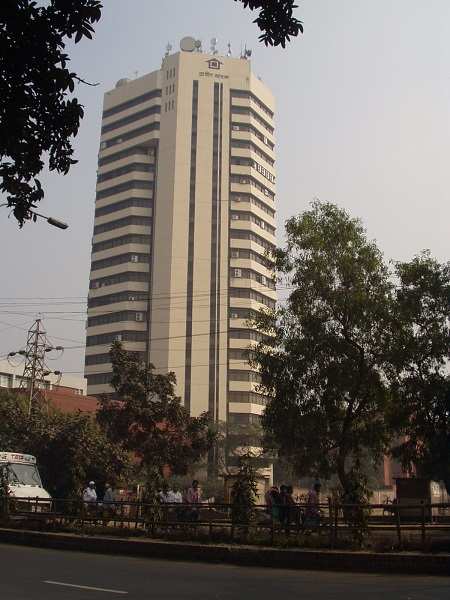
The Bangladesh prime minister has launched a sharp attack on Nobel laureate Muhammad Yunus after a Canadian court let her government off the hook on the Padma bridge issue
~By Seema Guha
Nobel laureate Muhammad Yunus is not Bangladesh Prime Minister Sheikh Hasina’s favourite person. Ever since a Canadian court, earlier this month (on February 10), dismissed the case against two former executives of a Canadian engineering firm, SNC-Lava, accused of bribing Bangladeshi officials, the attack on Yunus has become sharper. Much of this is led by Sheikh Hasina and her son, Sajeeb Wazed Joy. With the prime minister setting the tone, the entire government as well as party leaders are baying for his blood.
The controversy dates back several years. The World Bank, which had pledged $1.2 billion for a bridge over the river Padma, pulled out of the project in July 2012 because of concerns that the SNC-Lava officials were paying Bangladeshi officials to get approval. The World Bank made much noise about corruption in the highest quarters of government while pulling out. This was a major setback for the Awami League government and its international reputation. Bangladesh saw it as a conspiracy and linked it to the government’s move to remove Yunus as director of Grameen Bank.
Earlier, on two occasions (September 2011 and April 2012), the World Bank had submitted its concerns about corruption in high places to Hasina. The Awami League government was forced to act on the World Bank report. The minister for communications, Syed Abdul Hossain, had to step down. A senior secretary was arrested. The prime minister’s adviser, Moshiur Rahman, had to go on leave. Later, after an investigation, the Bangladesh government dismissed the allegations.

However, the World Bank pulled out in 2012, with the following comments: “The World Bank cannot, should not, and will not turn a blind eye to evidence of corruption… We have both an ethical obligation and a fiduciary responsibility to our shareholders and IDA donor countries. It is our responsibility to make sure IDA resources are used for their intended purposes and we only finance a project when we have adequate assurances that we can do so in a clean and transparent way.”
Bangladesh decided to go ahead with the project by raising its own resources. The multi-modal bridge is still being constructed. However, the Canadian court’s judgment has come as a shot in the arm for the Awami League. Two of the SNC-Lava executives as well as a Bangladeshi-Canadian national, against whom the corruption charges were levelled, were let off as the judge threw out the wire tapping evidence provided by the Canadian police. The police were also rebuked by the judge who said much of evidence was based on “gossip and rumours.’’ With the case of bribery against the SNC-Lava officials thrown out, Sheikh Hasina and the government feel vindicated.
Right from the beginning when the World Bank accused Bangladesh of corruption, the Prime Minister and her aides felt that Muhammad Yunus had influenced the ugly withdrawal. There is no evidence to back the claim, but it was made on the assumption that Yunus, who counts Bill and Hillary Clinton as friends, had a hand in it. Hillary Clinton was then the US Secretary of State.
Sheikh Hasina is now charging Clinton, the US State Department which she headed as well as the then American ambassador in Dhaka, of exerting pressure to ensure that Yunus was not forced out as managing director of Grameen Bank. In 2011, he was pushed out of the micro-finance company, which lifted thousands of Bangladeshi women from poverty.
Since the recent court order, Sheikh Hasina and her son, Sajeeb Wazed Joy, besides the entire ruling party have trained their guns on Muhammad Yunus. During her recent visit to Germany, the prime minister spoke of the Padma bridge controversy and charged American officials of browbeating her son not to remove Yunus as managing director of Grameen Bank.
“Hillary Clinton phoned me and exerted the same pressure. Even the US State Department summoned my son Joy three times and told him that we would face trouble,” she said. “Convince your mother,” she recalled Joy saying, quoting State Department officials. “The US ambassador always came to my office and threatened me that the fund for the Padma bridge would be stopped if Dr Yunus was removed from the managing director’s post of Grameen Bank. These remarks were made to Awami League supporters, who had gathered in Munich to greet the PM, while she was attending the Munich Conference.
Accusations against Yunus by the Awami League range from influencing the World Bank to scrapping the Padma bridge financing on charges of high-level corruption, tax evasion and illegal transfer of donor funds. All of these charges are regarded as baseless by the average Bangladeshi. The Yunus Centre, a think-tank founded by the Nobel laureate, said in a statement: “He has been accused, in harshest language and terms, of being behind false allegations of corruption in the Padma bridge project and the suspension of funds for the Padma bridge. Prof Yunus has never made any statement private or publicly to anyone about the possibility of corruption in the Padma bridge project at any time. We condemn the false and baseless accusations.”
Interestingly, the prime minister’s animosity against Yunus dates back to 2007, when the Bangladeshi army was backing a caretaker government and a move was on to get the two squabbling begums, Khaleda Zia and Sheikh Hasina, out of Bangladesh politics. Both were locked up. The army and the bureaucrats who were then the power centre, anointed Muhammad Yunus as a refreshing alternative. His image was clean, he was admired and known internationally as a Nobel laureate and had lifted thousands of women from poverty in Bangladesh. The move fizzled out, but Sheikh Hasina, though in power for two terms since then, has apparently not forgotten that incident.
With the prime minister herself publicly airing her views, the party and government leaders have followed. The High Court has issued a statement seeking for trial of the Padma bridge “conspirators”.
Like every South Asian country, the ruling party, the government and officials are out to prove their loyalty to the prime minister, and more and more outrageous demands are likely to be made. Sadly, Sheikh Hasina herself has raised the pitch.

